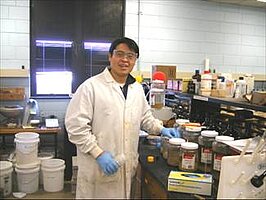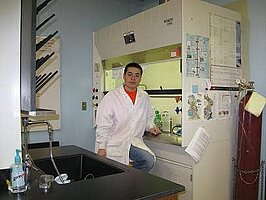Development of GAC-NZVI Adsorbent for Arsenic Removal

Qigang Chang is a Ph.D student in Environmental and Conservation Science Program at North Dakota State University. He received a Master of Science (2006) and a Bachelor Degree (2001) in Environmental Engineering from East China University of Science & Technology (ECUST), China. Currently, he is working on the project to develop a new adsorbent-GAC-NZVI to remove arsenic from drinking water.
qigang.chang@ndsu.edu
Fellow: Qigang Chang
Advisor: Dr. Wei Lin, Ph.D., Associate Professor, Department of Civil Engineering, North Dakota State University
Degree Progress: Ph.D. in Environmental Science expected in December 2009
Development of GAC-NZVI Adsorbent for Arsenic Removal
From the 1890s to 1940s, arsenic-laced bait was used extensively throughout North Dakota to combat grasshopper infestations. The bait, which included arsenic trioxide, sodium arsenate, Paris Green and other arsenic compounds, was commonly applied to farm fields. Unused materials were often buried or dumped in pits and low-lying areas. Groundwater was heavily contaminated with arsenic. A superfund site, located in parts of Ransom, Richland, and Sargent counties, was approved in 1983. Intensive remedy efforts were taken, and in 1996, this site was removed from the National Priority List. On January 22, 2001, the USEPA revised the maximum contaminant level (MCL) of arsenic downward from 50µg/L to 10µg/L. All the remedy facilities in this former superfund site are no longer able to protect people’s health under the new MCL of arsenic.
Western North Dakota also has elevated arsenic in groundwater. The arsenic level is approximately 24µg/L in all three wells supplying drinking water at Oakes and is around 40 µg/L at Devils Lake. The new regulation presents a major compliance challenge to the existing water supply systems, especially the small rural community systems that until recently had few regulation requirements. Some small communities are attempting to apply for regulatory exemptions due to the high costs associated with meeting the new MCL. While exemptions offer temporary cost savings, they do not defend the population from possible negative health impacts. There is an urgent need to develop safe and affordable technologies to meet the new drinking water standard in small rural communities in North Dakota.Granular Activated Carbon (GAC) is an excellent stable adsorbent widely used in water treatment process, especially for organic contaminants. But GAC alone only exhibits limited adsorption capacity to arsenic. Research found that arsenic adsorption capacity increases significantly after activated carbon is impregnated with iron
The proposed research hypothesizes that GAC-NZVI (nano zero valent iron) could be synthesized with desired amount of nano iron which are stable and highly reactive. GAC-NZVI could be a promising adsorbent to treat trace arsenic in drinking water by inheriting advantages from GAC and NZVI while avoid their drawbacks. GAC-NZVI could be directly used in existing GAC fix-bed system without additional extension and separation. Organic compounds may still have access to the huge specific surface of GAC so that GAC-NZVI will retain the ability to remove odor, taste, and color.
Project Objectives:
The primary goal of this research is to develop GAC-NZVI adsorbent to treat arsenic to meet current stringent drinking water standard at an affordable cost for rural communities in North Dakota. The specific objectives are as follows:
- To develop a method to synthesize GAC-NZVI adsorbent with desirable characteristics for arsenic removal;
- To determine the adsorption capacity and kinetic for arsenic removal using GAC-NZVI adsorbent;
- To study the mechanisms of arsenic removal and factors that affect arsenic removal capacities and efficiency by GAC-NZVI adsorbent; and
- To predict the performance of the GAC-NZVI adsorbents at various chemical conditions through model simulations.
Experimental and analytical studies will be carried out to achieve the above objectives. Groundwater samples from several locations of North Dakota, including Lidgerwood, Richland and Oakes, will be used to evaluate the performance of GAC-NZVI.
Progress :
The principle hypothesis has been proved that high amounts of iron could be impregnated in GAC with an even-distribution. A new impregnation method has been developed and 12.62% and 8.52% iron were impregnated in GAC Darco 20×50 and Norit RX3 EXTRA, respectively.
GAC-Iron has been characterized by Scanning Electron Microscopy (SEM) coupled with Energy Dispersive X-ray unit. SEM analyses indicated that 12.62% iron evenly distributes inside GAC Darco 20×50. And nano-level iron particles were observed in SEM images. X-ray Diffraction analyses indicated that iron exists inside GAC both in crystal structure (α-FeOOH) and amorphous status.
Arsenate synthetic water was used in adsorption tests. The pH of isotherm tests were controlled neutral by using bicarbonate buffer solution so as to keep conditions close to the natural water. Three levels of iron content in GAC-Iron Darco 20×50, 1.48%, 5.92% and 12.13%, were used to conduct arsenate isotherm tests to determine the arsenate adsorption capacities. The Langmuir model (Equation 1) fits the isotherm curves better than the Freundlich model.(1)
GAC-Iron with 5.92% and 12.13% iron content exhibited much higher arsenate adsorption capacity than GAC-Iron with 1.48% iron content. In the Langmuir model, parameter b represents the affinity of adsorbent for arsenate. In present research, GAC-Iron showed a higher affinity for arsenate than other research in literature, such as 1.12 L/mg reported by Gu et al.(2005) and 0.18L/mg reported by Chen et al.(2007). In addition, GAC-Iron exhibits the comparative adsorption capacity at low arsenate concentration (<200µg/L), which represents most real-world cases. Challenges were encountered in arsenate adsorption tests. No difference of adsorption capacity was observed between GAC-Iron with 5.92% and 12.13% iron. The reasons are not clear, and further research will identify impact factors and modify the synthesizing method to produce GAC-Iron that has enhanced arsenate adsorption capacity.
Significance:
GAC-NZVI will be a promising adsorbent that could be used to remove arsenic from drinking water at existing facilities without further expansion. The GAC-NZVI adsorbent could meet the stringent drinking water standard of arsenic at affordable cost and help rural communities of North Dakota to comply with federal regulations. In addition to the benefits to North Dakota, sharing of knowledge from this research will benefit the environmental community as a whole and encourage additional research to create new technologies by combination of latest technologies with conventional technologies.


Wei Lin
Civil & Environmental Eng.
Office: Civil/Ind Eng 201D
Telephone: 701-231-6288
Email: wei.lin@ndsu.edu


